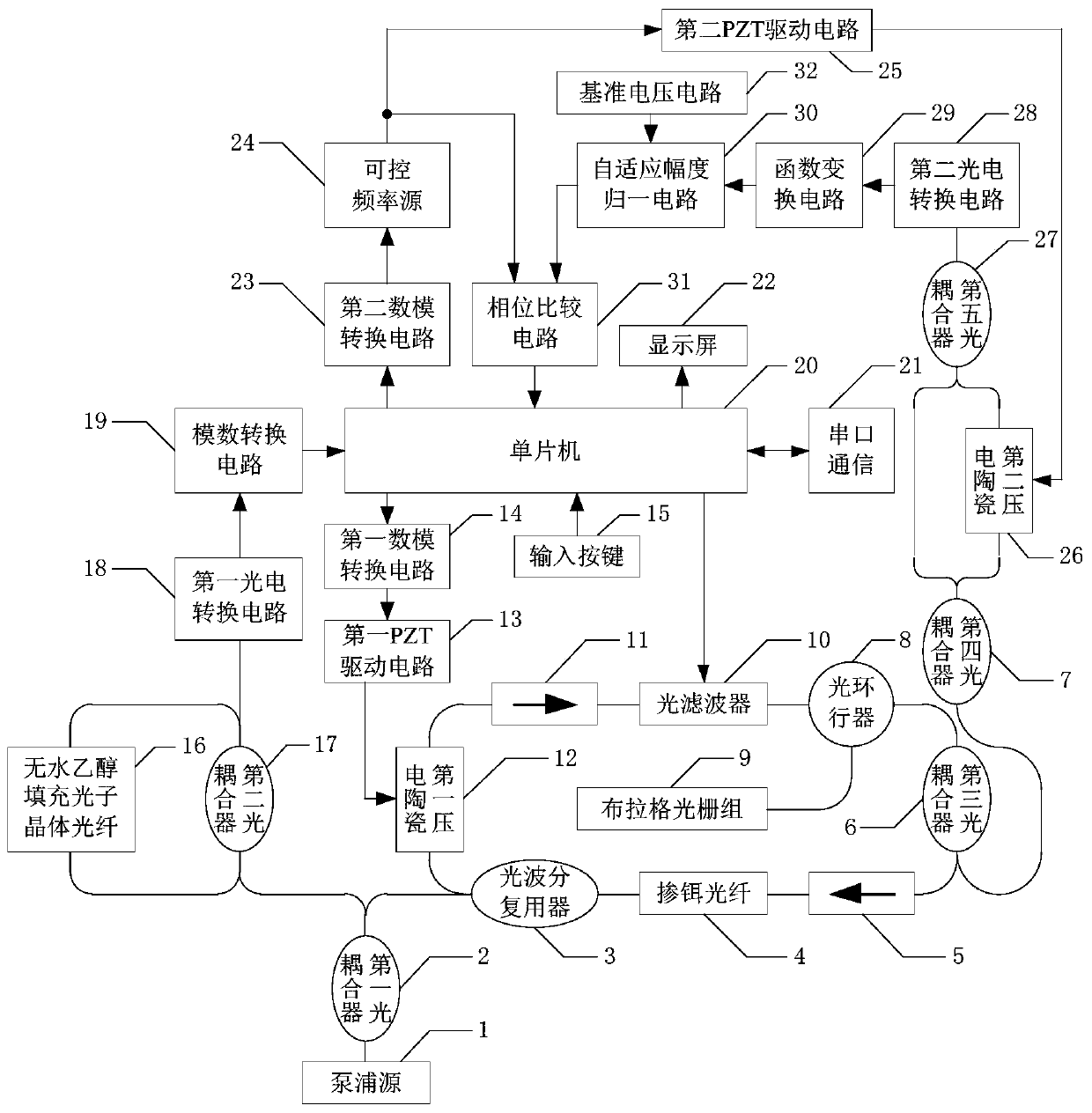A Stress Sensor Based on Mach-Zehnder Interference Structure
A technology of stress sensor and interference structure, which is applied in the direction of measuring the change force of optical properties of materials when they are stressed, can solve the problems of variable frequency, difficult to filter out, unfavorable optical fiber sensors, etc., and achieve reliable work , The effect of small phase detection error
- Summary
- Abstract
- Description
- Claims
- Application Information
AI Technical Summary
Problems solved by technology
Method used
Image
Examples
Embodiment 1
[0028] Example 1 Overall structure of the present invention
[0029] Such as figure 1 As shown, the overall structure of the present invention has a pump source 1 (980nm laser, maximum output power of 1W) and a first optical coupler 2 (produced by OZ-OPTICS company, model FUSED-12-1064-7 / 125- 90 / 10-3U-3mm, the splitting ratio is 90:10) the input end is connected, the 90% output end of the first optical coupler 2 is connected to the 980nm of the optical wavelength division multiplexer 3 (980 / 1550nm wavelength division multiplexer) The 1550nm end of the optical wavelength division multiplexer 3 is connected to one end of the optical fiber wound on the first piezoelectric ceramic 12 (cylindrical piezoelectric ceramic, outer diameter 50mm, inner diameter 40mm, height 50mm), and is wound on the first pressure The other end of the optical fiber on the electroceramic 12 is connected to the input end of the first optical isolator 11 (1550nm polarization-independent optical isolator), and...
Embodiment 2
[0031] Example 2 Function Conversion Circuit
[0032] Such as figure 2 As shown, the structure of the function conversion circuit 29 used in the present invention is that one end of the capacitor C3 is connected to the pin 12 of the trigonometric function converter U1 (AD639) and one end of the resistor R2, and the other end of the capacitor C3 is used as the function conversion circuit 29. The input terminal of, denoted as port ACOS_in, is connected to the output terminal of the second photoelectric conversion circuit 28; the other end of the resistor R2 is grounded; the pins 2, 3, 4, 5, 8, 11, and 13 of the trigonometric function converter U1 are grounded , The pins 9 and 10 are connected to one end of the capacitor C2 and the -12V power supply, and the other end of the capacitor C2 is grounded; the pin 6 of the trigonometric function converter U1 is connected to the pin 7, and the pin 16 is connected to the +12V power supply and the capacitor C1 One end is connected, the othe...
Embodiment 3
[0033] Embodiment 3 Adaptive amplitude normalization circuit
[0034] Since the amplitude of the signal output by the function conversion circuit 29 is small and is affected by multiple parameters in the optical path and the circuit, the magnitude is uncertain. Therefore, the present invention designs an adaptive amplitude normalization circuit 30 to convert the signal output by the function conversion circuit 29 The amplitude of is normalized to the optimal size to further improve the accuracy of demodulation. The specific structure is that one end of the capacitor C11 is connected to one end of the resistor R21 and the pin 3 of the chip U2, the other end of the resistor 21 is grounded, and the other end of the capacitor C11 is used as the input end of the adaptive amplitude normalization circuit 30, denoted as port ADAPT_in , Connected to port ACOS_out of function conversion circuit 29; pin 1, pin 7, pin 8, and pin 14 of chip U2 are all grounded, pin 2 and pin 4 are both connec...
PUM
| Property | Measurement | Unit |
|---|---|---|
| wavelength | aaaaa | aaaaa |
| reflectance | aaaaa | aaaaa |
Abstract
Description
Claims
Application Information
 Login to View More
Login to View More - Generate Ideas
- Intellectual Property
- Life Sciences
- Materials
- Tech Scout
- Unparalleled Data Quality
- Higher Quality Content
- 60% Fewer Hallucinations
Browse by: Latest US Patents, China's latest patents, Technical Efficacy Thesaurus, Application Domain, Technology Topic, Popular Technical Reports.
© 2025 PatSnap. All rights reserved.Legal|Privacy policy|Modern Slavery Act Transparency Statement|Sitemap|About US| Contact US: help@patsnap.com



